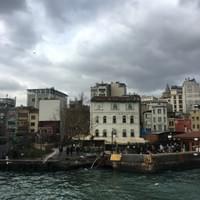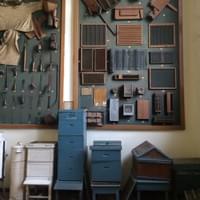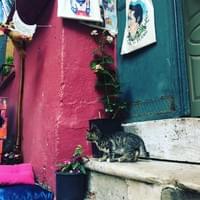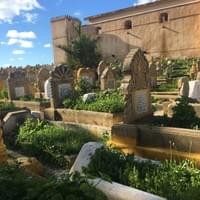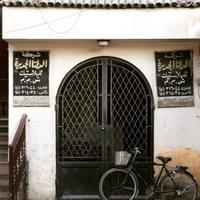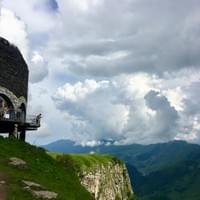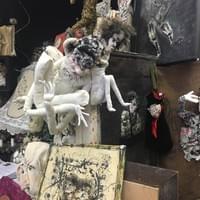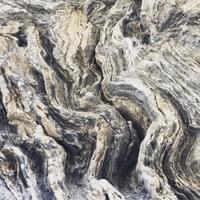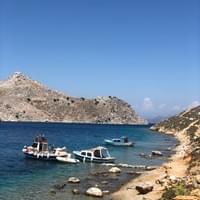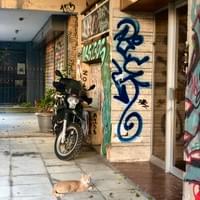
Taylor M. Moore
Historian of the Modern Middle East
magic + medicine + museums
ABOUT ME
historian + writer

📸: Mariah Miranda Photography
Taylor M. Moore is a historian of the Modern Middle East, specializing in nineteenth- and early twentieth- century Egypt. She is an Assistant Professor of History at The University of California, Santa Barbara where she is teaching and writing her first book, Amulet Tales: Race, Magic, and Medicine in Egypt. She is also a Junior Fellow in the Andrew W. Mellon Society of Fellows in Critical Bibliography at the University of Virginia's Rare Book School.
Taylor's broader research and teaching interests lie at the intersections of critical race studies, gender and sexuality studies, decolonial materiality, and histories of science, technology, medicine, and the occult in the non-West. Her work is invested in illuminating the occult(ed) networks, economies, and actors whose knowledge, bodies, and labor are generally rendered invisible in Eurocentric histories of global science.
Born and raised in southern Louisiana, Taylor received her Ph.D. in History from Rutgers, The State University of New Jersey. She holds a dual BA in Honors Political Science and Sociology from the American University in Cairo. Taylor’s research has been funded by The Harvard Academy for International and Area Studies, the University of California President’s Postdoctoral Fellowship, Ford Foundation Predoctoral and Dissertation Fellowships, the Social Science Research Council, and the Council for American Overseas Research Centers.
In addition to her writing and research, Taylor has worked as an editor for the Arab Studies Journal and History of Anthropology Review. She works intimately with ethnographic collections, and intends to curate her own exhibit in the near future. Outside of the academy, Taylor is a semi-professionally trained vocalist specializing in late Renaissance polyphonic and early baroque music. She most recently performed with the early music collegium, Aura Polyphonica. She enjoys singing, as well as reading and writing horror/speculative fiction.
RESEARCH + Creative PROJECTS

Amulet Tales
Book Manuscript-in-Preparation
My first book project, Amulet Tales: Race, Magic, and Medicine in Egypt uses amuletic objects as archives to reveal how Upper Egyptian and Black African women healers—and the amulets they wielded—shaped the global development of anthropological expertise and the robust spiritual economy of healing in nineteenth- and early twentieth-century Egypt. Despite repeated campaigns by government officials and doctors to discredit their knowledge and outlaw their practices, wise women controlled a widespread market in occult objects that remained crucial in the everyday lives of Egyptians. The project combines Middle East history’s rich foundation of women’s and gender history, with insights from science and technology studies, critical race theory, and budding scholarship on the Islamicate occult sciences, to consider how racialized constructions of the Upper Egyptian and Black African women—along with the socio-medical, spiritual, and economic worlds they inhabited—shaped the making of “modern” Egypt. The development of anthropological thought in interwar Egypt and abroad, I argue, hinged on the study of “superstitious” healing practices (khorafa) or “old wives medicine” (tibb al-rukka) attributed to Upper Egyptian and enslaved and manumitted Black African healing practitioners. Wise women and their amulets found themselves entangled in the internationalization of social sciences not as mere objects of study or ‘go-betweens’ but critical producers of knowledge.
Amulet Tales brings the tools and practices of Islamic occultism to the forefront of recent explorations of decolonial/postcolonial science studies, placing women and Black Africans at the center of this knowledge production. This study draws upon an archival material from Egypt, Turkey, France, and the UK in Arabic, English, Ottoman Turkish, and French. It relies on amulets and talismans collected in Egypt by anthropologists, medical officials, and private collectors between 1900 and 1930—and particularly those procured by anthropologist Winifred Blackman— as archival sources for the intellectual and social histories of working class women, enslaved Africans, and Upper Egyptian migrant workers who left few documents in traditional archives. These amulets—which ranged from copper fear cups and animal teeth to plant matters and human remains—were key technologies that blurred “the illusory boundary” between humanity and nature, as well as the material world and the realm of the unseen. Modern Egyptian amulets are a crystal ball of sorts which allow historians to partially reconstruct the complex constellations of objects, practitioners, and laborers that made up the political and spiritual economies of healing in Egypt and the late Ottoman world, particularly in light of a historiography that argues the metaphysical powers of magical objects and otherworldly beings was replaced by the those of the modern state.

Living Fossils
Second Book Project
My second monograph, Living Fossils, interrogates how Egyptian and European agricultural scientists, race scientists, doctors, and entomologists theorized the body of the Egyptian fellah as an entity that metaphorically and materially straddled the boundaries between “environment” and “technology” in Egypt during the nineteenth and early twentieth century. Mythologized as ancient technologies born from the mud of the Nile itself, the laboring bodies of the Egyptian fellahin (peasantry) were central to the making of modern Egypt. The project draws from critical race theory and histories of environment and technology to explore how the racialized bodies and bodily labor of the Egyptian peasantry subsidized the development of the global disciplines of medicine, anthropology, archaeology, entomology, and agricultural science. I show that the violent extraction of their labor took place when they were alive—in the field, factory, and in the birthing clinic—and continued after death on the dissection table.
Writing
Peer-Reviewed Articles and Public-Facing Writing
SPEAKING
Invited Talks + Conferences + Workshop Presentations
UPCOMING/RECENT:
30 March 2023: Living Fossils: Anatomies of Race and Reproduction in Modern Egypt, Department of the History of Science Colloquium, Department of History of Science, Harvard University
INVITED TALKS:
4 October 2021: "Down to the Bone: Dissecting Blackness in Khedival Egypt," HSHM/SHEA Lecture Series, Department of History of Science and Medicine, Yale University
18 September 2021: "Divining (Across) Distance: An Amuletic Approach to the Humanities," Keynote Lecture presented at the Across Distance: 2021 Cambridge AHRC International Conference, Cambridge University
18 March 2021: “Down to the Bone: Dissecting Blackness in Early Twentieth-Century Egypt,” Blackness in Asian and Middle Eastern Studies Speaker Series, Department of Asian and Middle Eastern Studies, UNC Chapel Hill.
1 February 2021: “‘Living Fossils: Pelvic Bones and Fertile Wombs as Objects of Natural History in Egypt,” Monday Seminar Series, History Department, Johns Hopkins University.
29 January 2021: “Amuletic Archives: Writing Magico-Material Histories of the Middle East,” Historiography of the Middle East Series, Center for Near Eastern Studies, UCLA.
23 November 2020: "Tracing the Magical Rhinoceros Horn in Egypt: A Decolonial Materialist History," History of Science, Technology, and Medicine Colloquium, UCLA.
31 October 2020: "The Curse of the Black Eggplant: Reconstructing Occult Economies in Late Ottoman Egypt," The American Research Center in Egypt (ARCE) Lecture Series, Cairo.
28 October 2020: "Pharaohs on the Operating Table: Race, Sex, and Medicine in Semicolonial Egypt," The Center for Middle Eastern Studies, University of California, Berkeley.
5 April 2018: “‘Living Fossils’: Pelvic Bones and Fertile Wombs as Objects of Natural History in Semicolonial Egypt,” History and Philosophy of Science Colloquium, Stanford University.
20 March 2018: “Living Room Magic: Tibb al-Rukka and Ritualistic Ethnography in Interwar Egypt,” American Philosophical Society Brown Bag Lunch Series, Philadelphia, PA.
SELECTED CONFERENCES + WORKSHOPS:
November 2022: Roundtable Participant, "Gender and Technology: The State of the Field", Society for the History of Technology (SHOT) Annual Meeting
November 2019: “Ethnographic Magic Revisited: Conjuring Histories of Indigenous Science from Egypt’s Anthropological Archive,” American Anthropological Association Annual Meeting, Vancouver.
November 2019: “Occult(ed) Ontologies,” Panel: Magical Materialities Toward a History of (Occult) Technology in the Islamicate World from the 13th to the 21st Centuries, Middle East Studies Association Annual Meeting, New Orleans.
August 2019: “Shibbolethic Science: Bodies as Technology in the Egyptian Sugar Cane Industry (1890-1910),” Panel: Ottoman and Post-Ottoman Enviro-tech Histories, European Society for Environmental History Annual Meeting, Tallinn.
April 2019: “The Rhinoceros Horn and the Black Eggplant: An Experiment in (Un)Natural Histories,” Natural Things: Collection and the History of Science in the Age of Global Empires, Hamilton College.
January 2019: “Pills and Potions: Medicine, Magic, and Ethnography in Abdel Rahman Ismail’s Tibb al-Rukka,” Medical Mobilities in the Middle East and North Africa 1830-1960, Nazareth.
November 2018: “Fellah Entomology: Observing and Eradicating Bugs in the Great Locust Invasion of 1915,” Panel: Knowing Nature: Epistemologies, Scientific Exchange, and Exploration in the Ottoman Empire, 17th-20th Centuries, Middle East Studies Association Annual Meeting, San Antonio.
November 2017: “‘Living Fossils’: Pelvic Bones and Fertile Wombs as Objects of Natural History in Semicolonial Egypt,” History of Science Society Annual Meeting, Toronto.
July 2017: “Amulet Tales: Economies of Magic and Healing in Interwar Ethnographic Collections,” The Material Culture of Exploration and Academic Travel, 1700-1900, Gottingen Spirit Summer School, University of Gottingen, Germany.
March 2017: “The Wise Women and Winifred: Fertility Talismans and Ethnographic Collections in Interwar Egypt,” The Globalization of Science in the Middle East and North Africa, The College of the Holy Cross, St. John, MA.
April 2016: “Talismans and Tomb-Chapels: Winifred Blackman’s Collections as a Source for Modern Egyptian History,” The Object Habit: Legacies of Fieldwork and the Museum,” University College London, London, England.
October 2015: “Cane Cultivators, Sheyukh, and Magical Eggplants: The Political and Spiritual Economy of Plants in Khedival Upper Egypt,” American Folklore Society Annual Meeting, Long Beach, California.
March 2014: “Superstitious Women: The Cultivation of the Upper Egyptian Fellaha and the de-Africanization of Egyptian Memory,” The Eighth Annual Greater New York Area African History Workshop, Princeton University.
Teaching + Syllabi
I am equipped to teach online and in-person undergraduate survey courses on the history of the Middle East and Islamic World; histories of science, technology, and medicine/magic; women's and gender history; and critical race theory. I also teach upper-level undergraduate seminars and graduate courses like Decolonial/Postcolonial Science Studies; Science, Technology and Medicine in the Middle East; and Race (and) Science in Global History; as well as thematic classes on magic and occultism in global history (with an emphasis on the Islamicate World), museums and collecting, and feminist decolonial technoscience.
Using both traditional and non-traditional archives, I believe that it is my role to cultivate what I have come to call ‘critical imagination’ in my classroom. Imagination as a critical pedagogy forges a connection between the imagination and lived reality. In my courses on Middle East History, Gender and Sexuality Studies, and Science and Technology Studies I hope to compel students to move beyond rote memorization and critique to imagine alternative possibilities both in their academic work and daily lives. Diversity work and inclusive pedagogies are at the foundation of my passion for research, service work, and teaching in the university. I will work with my colleagues and students to provide an inclusive and engaging university environment—one where students can gain exposure to and research the diversity of human experience in the fields of Middle Eastern and North African History, Science and Technology Studies, and Race, Gender, and Sexuality Studies.
See some examples of courses I have designed below. Please contact me email for more information and/or syllabi.

‘Searchers After Horror’: A Global History of Science Through Science Fiction
This is an introductory level course designed to meet humanities and global core requirements. Taking its name from the Lovecraftian phrase used to describe 19th century explorers to the Congo, the course provides a survey of major events and historiography in the global history of science from the medieval to modern periods, using science fiction short stories as its primary sources. It is organized thematically by power/colonialism, gender, race, and non-western approaches to science. Each theme is framed by a selection of short stories which speak to the weekly readings. This course will show how hopes and anxieties about scientific progress were reflected in science fiction literature, as well as how scholars in the non-west/of non-western traditions have looked to science fiction to narrate histories of knowledge production that have gone ignored as “scientific” or worthy of history of science’s canon.

Science and Technology in Middle Eastern History
This course is a seminar that explores the history of science and technology in the Modern Middle East. Ranging historically from the Islamic medieval period until present day, the course will introduce students to a selection of texts that address and challenge key themes of “science,” “technology,” “progress,” etc. that have proliferated in the field of Middle East history since its inception. We will cover topics ranging from eugenic science, rational medicine, and ethnography to jinn and talismanic magic. Additionally, this course will prepare students to embark on their own original research papers using archival and primary sources.

Cairo Time: History through the Lens of the “Victorious City”
This introductory online course will allow students to ‘travel’ to the city now known as Cairo, and watch it grow and develop from being a relatively small merchant city in the Ottoman Empire to a sprawling megalopolis that has become one of the centers of the Arab Spring in the 21st century.

Medicine and Healing in Islamicate Societies
What role did medicine and healing play in medieval Islamicate societies—and what role do they continue to play in Islamicate societies today? This seminar explores the ways that medicine impacted the social and intellectual life-worlds of communities in the Islamicate world from the medieval to the modern period. The course follows the development of medicine (tibb) and healing practices (shifa) from the time of Ibn Sina to the role of physicians and medical discourse in more contemporary political events, like the Arab Spring, and militarized spaces like occupied Kashmir. Throughout this course, students will be introduced to and learn to analyze primary sources in the history of medicine and healing in Islamicate societies. The sources range from more traditional written sources (excepts from manuscripts, fatwas, medical treatises, etc.) to objects and visual materials. Together, we will utilize these sources to reflect on the impact of medicine and healing practices on the production of the discourses and practices of power, gender, race, disability, and sexuality.We will also explore questions of magic, jinn-possession, and “vernacular” healing practices within the trajectory of Islamic medicine—and ultimately consider or problematize their distinction from “modern” medicine or biomedicine in the 19th and 20th centuries.
Image: "Water Carrier Suffering from Tetanus in Zagazig Hospital" (Sobhy, 1908)
© 2019







